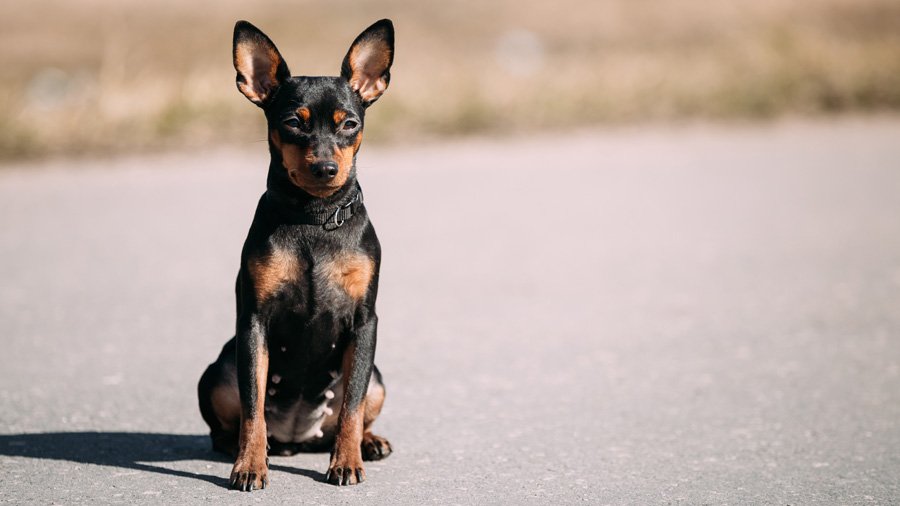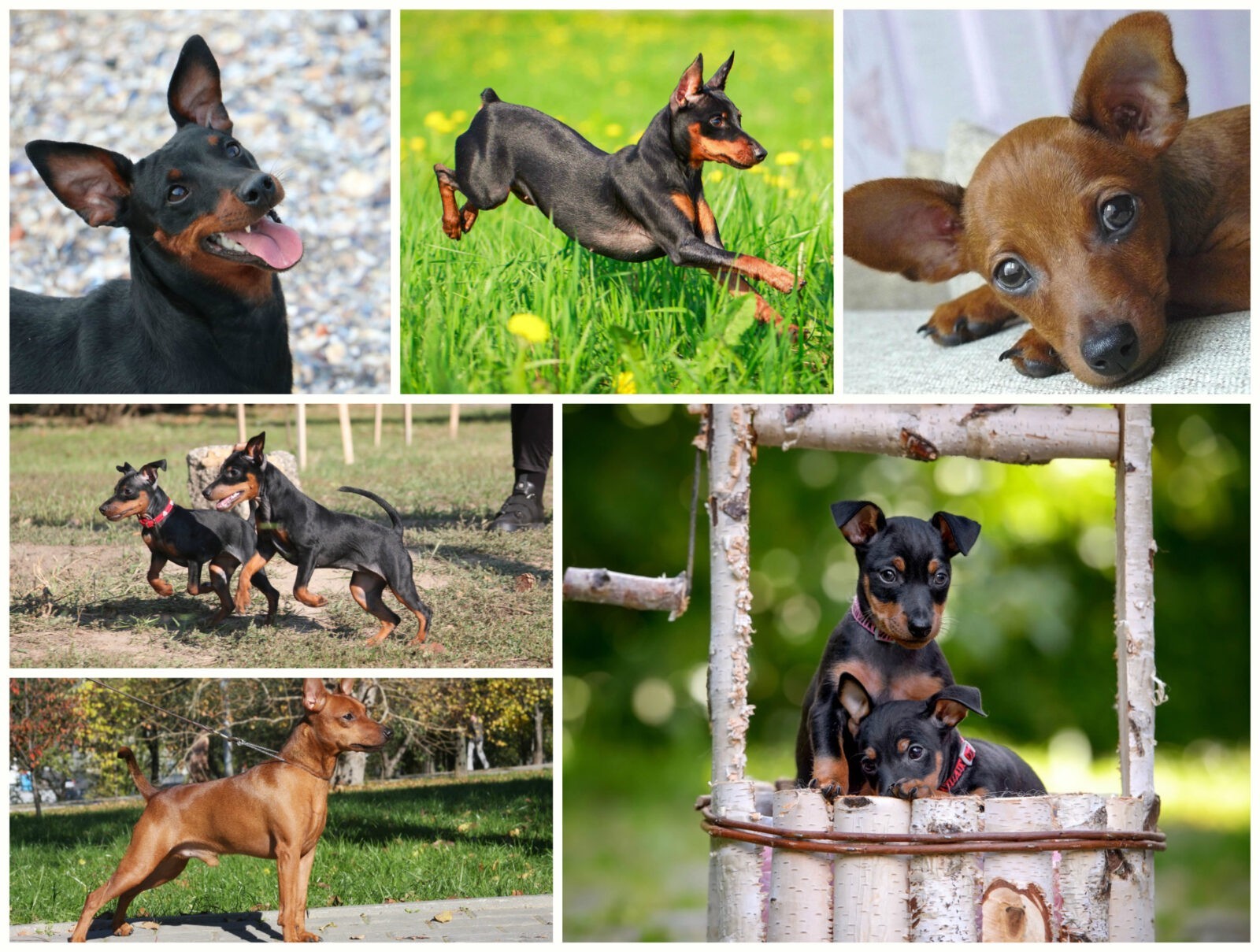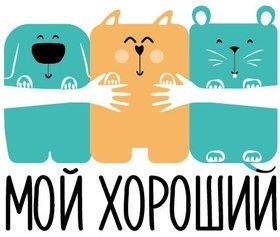
Brief description of the Miniature Pinscher breed
The dog of this breed is often described as energetic and fearless. A feature of the breed is an extravagant gait, when the dog raises its front legs, bending them at the wrist. The breed is also classified as decorative, but the miniature pinscher himself is sure that he is a rather large animal. Curiosity is another character trait. Therefore, it is immediately necessary to hide all easily accessible things, including medicines.
The Miniature Pinscher is a family dog, it will protect its owner from potential intruders with fearlessness. Despite the fact that the dog is very affectionate, but still its somewhat impudent behavior is not quite commensurate with the size of the animal. The dog is somewhat stubborn, so the owner will have to make efforts in education.
A tiny pinscher can easily find a loophole to get through the fence without much effort. Regularly check your fence for damage and undermining, otherwise sooner or later the pinscher will find a way out and jump out into the street.
Due to the small amount of fat and hair, these dogs need protection from the cold. It is advisable to use a variety of clothes for dogs, while the main thing that needs to be protected from the cold is the stomach and chest.
Most toy breeds are difficult to train at home, and the Pinscher is no exception. Training must begin from the first day the dog enters the house.
Miniature Pinschers are prone to shedding, so they require systematic hair care. As a rule, it is enough to brush the coat a couple of times a week. Do not forget about the need to clean the ears and teeth of the pet, as well as trim the claws. This, perhaps, is all the requirements for caring for a dog.
The Miniature Pinscher is very cheerful, bold and active. He will become a great friend for all family members. The animal loves to be in the family circle, so you should not refuse your pet to participate in family picnics, evening walks and active games with family members. The main feature of the miniature pinscher is a crazy love for the owner. In fact, the only drawback of the breed is the tendency to dig and chase animals, mostly cats.
As already noted, the pinscher is a companion dog, so he must live under the same roof with the owner and be a full member of the family. Living a dwarf pinscher in the yard, in a garage or aviary is unacceptable.
basic information
| Breed name: | Miniature Pinscher |
| Country of origin: | Germany |
| The time of the birth of the breed: | 18th century |
| Type of: | pinscher and schnauzer |
| The weight: | 4 - 6 kg |
| Height (height at the withers): | 25 - 30 cm |
| Life Expectancy: | 13 - 15 years old |
|
ICF classification:
|
Group 2, Section 1, Room 165 |
| Puppies price: | 300 – 650 $ |
| Most popular nicknames: | list of nicknames for miniature pinscher |
Evaluation of the characteristics of the Miniature Pinscher breed
| Adaptability
(a definition meaning how easily a dog can adapt to changes in life) |
🐶🐶🐶🐶🐶 |
| Shedding level
(Level and frequency of hair loss in the animal) |
🐶🐶 |
| Tenderness level
(The level and amount of tenderness and affection that the dog gives in return for attention to itself) |
🐶🐶🐶🐶🐶 |
| Exercise needs
(Dog's daytime activity level) |
🐶🐶 |
| Social need
(The required number of contacts of the dog with other animals, as well as people) |
🐶🐶🐶🐶 |
| Apartment content
(A factor that determines the level of noise and other inconveniences that a dog can deliver to owners in relation to the size of the apartment to the size of the dog) |
🐶🐶🐶🐶 |
| Grooming
(The number of bathing, brushing, and the number of professional grooming sessions required for the dog) |
🐶 |
| Friendliness in an unfamiliar environment
(Features of the behavior of a dog in a society with strangers or in an unfamiliar environment) |
🐶🐶🐶 |
| Tendency to bark
(Tendency to bark and its frequency and volume) |
🐶🐶🐶🐶🐶 |
| Health issues
(Potential health status of the dog) |
🐶🐶 |
| Territoriality
(The dog's tendency to protect his home, yard, or even his owner's car) |
🐶🐶🐶🐶 |
| Friendliness to cats
(The tendency towards tolerance for cats and decreased manifestation of hunting instincts) |
🐶🐶🐶 |
| Intelligence
(The ability of the dog to think and solve emerging difficulties (not to be confused with learning!) |
🐶🐶🐶🐶🐶 |
| Education and training
(The level of difficulty in training the dog to perform certain actions) |
🐶🐶🐶🐶 |
| Friendliness to children
(A factor that determines how friendly a dog is to children, whether he likes to play with them and tolerate some childish pranks) |
🐶🐶🐶 |
| Game activity
(The concept is determined by its very name, and, as a rule, is found in almost all dogs) |
🐶🐶🐶🐶🐶 |
| Observation
(The ability of a dog to detect the presence of a stranger on its territory) |
🐶🐶🐶🐶 |
| Friendliness to other dogs
(The tendency of the dog to find common language with his other relatives) |
🐶🐶 |
Photo of a miniature pinscher:

The history of the origin of the miniature pinscher
Many people think that the miniature pinscher is a smaller version. doberman, but in fact, this breed appeared about 200 years earlier than the Doberman. It is believed that the breed was bred in Germany by crossing breeds such as dachshund, German Pinscher and Manchester Terrier. As a result, it was released small, but energetic and courageous doggy.
At first, the Miniature Pinscher gained popularity in Germany and Scandinavia, but the popularity of the breed began to grow rapidly. The Miniature Pinscher was registered by the American Kennel Club in 1925, however, as a terrier. The club of fans of this breed appeared already in 1929, and in 1930 the breed was retrained, so the Pinscher officially appeared. In 1972, another word was added to the name of the breed: "dwarf". Since then, this amazing dog and bears its current name.
The nature of the miniature pinscher
Maintenance and care
The Miniature Pinscher is very easy to care for as it has a short and smooth coat. It is enough to brush the dog a couple of times a week with a non-rigid brush. Miniature Pinschers shed very little, especially since they are small in size. dogs talk about a small amount of wool. Bathe dogs of this breed as needed. To do this, you need to use special shampoos that do not harm the coat.
Like most small breeds, Miniature Pinschers often have dental problems. Therefore, you need to brush your teeth as often as possible using a special paste prescribed by a veterinarian.
Nails are usually trimmed once every two weeks. If they are actively growing, then they can be cut as needed. True, if the dog regularly walks for a long time on the street, then the claws will grind off in a natural way, and this will facilitate the process of caring for the pet.
Training and education
Miniature Pinschers are used to getting what they want. This suggests that the training and training of these dogs is not an easy task. For many owners of these tiny dogs, training becomes a real challenge.
An experienced, demanding and consistent dog breeder, endowed with excellent leadership qualities, is able to train a miniature pinscher. Classes should be short, otherwise they will quickly bother the pet. A good way to stimulate learning are treats that the dog loves. A rough or aggressive attitude towards a pet will completely negate all efforts in training.
Don't go for your pet. If you give in even once to the dog, then the training will fail, as the animal will understand that it can manipulate you. Note that training and socialization should start at an early age.
Health and disease of the miniature pinscher
Some interesting facts
- The Miniature Pinscher is not a dog for beginners.
- The Miniature Pinscher loves games, whether they are played indoors or outdoors. Pinscher does not need active exercise, an evening walk may be enough for the normal development of your pet.
- It is better to keep these dogs in families in which children have reached an older age. The nature of the pinscher is somewhat aggressive if something does not go the way the animal would like it to. Therefore, the pinscher can harm a small child.
- A miniature pinscher can be with cropped ears and tail, or live with an uncropped tail and ears, there is not much difference in this, it all depends on the owner himself.
- The color of the pet can be red, red with black hair, black with reddish patches, chocolate and fawn.
- The Miniature Pinscher does not tolerate low temperatures well. In the cold season, he must be dressed in warm clothes.
- Since pygmy pinschers were bred to hunt rodents, they can attack small animals that will be perceived by the dog as prey.
- Miniature Pinschers are very active dogs.
- Miniature Pinschers are very active and very curious. For their proper upbringing, the owner must have a persistent character and leadership qualities.
Nurseries and breeders
We borrowed material from the wonderful site of our partners DOGCATFAN.COM about cats and dogs, the author dogcatfan
